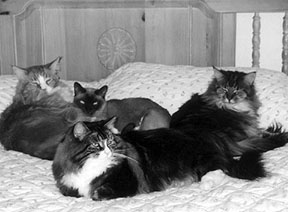For millions of years, small felines lived as solitary, territorial predators. Group living, especially at high densities, is not natural to them. But the cats that share our homes have tempered their wilder ways to fit more smoothly into our world.
Intelligent and adaptable, Felis catus has adjusted astonishingly well to life in groups, forming complex, dynamic social structures and peaceably sharing available resources. Unfortunately, feline group life is not always trouble-free.
The Game of Bullying
A problem that can arise is the identification of one cat in a group as a pariah or low cat on the totem pole – and fair game for bullying. The emergence of a perceived outcast might be due to any number of causes. Though anecdotal reports of pariah cats are easy to find, behaviorists disagree on the nature of this phenomenon.
Karen Overall, VMD, PhD, of the University of Pennsylvanias Center for Neurobiology and Behavior, views true pariah cats as rare – probably victims of severe early deprivation. In the 15 years Ive been in the field, the only pariah cats Ive seen were abandoned on the street and missed all early periods of exposure to humans and other cats. Also, their brain development may have been affected by malnourishment in utero, making these cats more reactive than others, and thus their interactions with other cats problematic, says Dr. Overall, who is board certified by the American College of Veterinary Behaviorists,
I think that personality can be a contributing factor to the pariah problem because pariahs do occur in very small social groups, says Alice Moon-Fanelli, PhD, clinical assistant professor at Tufts University School of Veterinary Medicine. It may be worse with indoor cats since they dont have an escape route. Personality differences between cats depend on genetics and experience, so its important to get a good match when youre trying to have several cats live together.
Myrna Milani, DVM, consultant and author of CatSmart, views the pariah phenomenon as primarily one of owner perception – or even creation. Social structures in cats arent fixed – theyre dynamic, she notes. Animals in one situation may act dominantly, and in another set of circumstances act submissively. When you look at a behavior at any point in time, its not the animal thats submissive, for example, its the behavior. Too often, people label the animal and create certain expectations.
Some people want all of their cats to be social, continues Dr. Milani. Then they acquire a cat whos more solitary – more catlike – and they assume that theres a real problem. But she also cautions, If a cat suddenly starts isolating himself, bells should go off because sick or depressed cats will isolate themselves. If so, schedule a visit to the veterinarian.
Observes Dr. Overall, Most of the cats in households who are marginalized are either the victims in intercat aggression, or they have been victims of a redirected event and have marginalized themselves because the attack was so unprovoked.
Humans: Stay Out Of It!
You do see displaced aggression in cats, says Dr. Milani. Its a normal, protective mechanism that a more dominant animal uses to dissipate the hormonal and physiological changes associated with stress. The first time it happens, the target cat naturally freaks. But in my experience, if the owner stays out of it, the cats are extremely good about reading body language. They know when this is coming, and they get out of the way. But if the owner seeks out the victim and babies him, it reinforces the behavior. Often, the only time the cats display this behavior is when the owner is around.

288
One of Dr. Milanis clients brought home a male kitten that was a hellion – constantly jumping on the other cats. Three of the wise older cats formed a kitten-training alliance. When Little Hellion got out of hand, they simply stalked him. The kitten would scream bloody murder, quickly learning that his owner would immediately come running to save him, thus keeping the game going. The owner was desperate to stop the older cats from picking on him! Ultimately, to stop the behavior, describes Dr. Milani, we needed to stop the owner from interfering.
Dr. Milanis advice? Dont meddle! She does caution that if intercat aggression is continual and escalating, or if the cats are not eating and drinking normally, or theyre marking and spraying all over, its time to step in. Dr. Moon-Fanelli agrees. Continued stress from a cat terrorizing and stalking another cat can lead to litter box problems as well as other behavioral problems for the pariah.
For cat owners, its a balancing act. I think it all boils down to basic knowledge, says Dr. Milani. Once you know where the cats are coming from, you can look at these situations from the vantage point of knowledge rather than emotion. I remember one situation of displaced aggression where the owner decided that it was a psychotic event and went to unbelievable lengths to keep the cats separated. But one of the cats learned how to open the door. The cats would stay in their respective parts of the house during the day, but once the owner went to sleep, one cat would open the door and the two cats would spend the night together!



